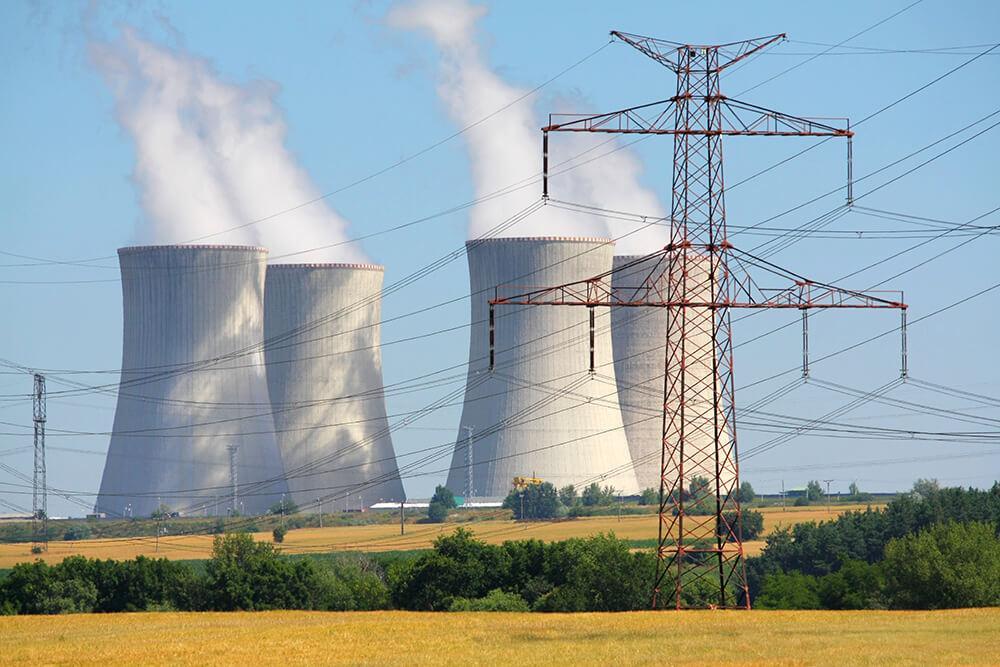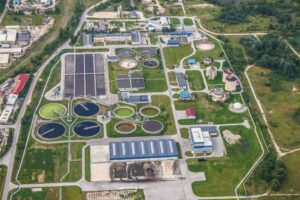05/27/2024 | Conductivity | 16 MINUTE READ
Monitoring Conductivity in Power Plants and Utility Applications

When you’re testing water quality, there are numerous measurements you can use, which include everything from pH and turbidity to conductivity and temperature. In power plants and utility applications, monitoring conductivity is essential. This measurement allows you to identify how many contaminants are in the water.
When it comes to steam generation applications, the quality of the water must be properly maintained to prevent scale buildup and corrosion. Many power plants use a demineralization process to make sure the water remains ultra-pure. Conductivity sensors are placed in each bed to consistently monitor the solution and make sure the ion-exchange resins are replaced when needed.
In boiler feedwater, many industrial facilities perform conductivity measurements to verify water quality and inform operators if there are too many contaminants in the water. Conductivity measurements tell you when the temperature and salinity of the water increase. In this scenario, the quality of the water will worsen.
Higher conductivity readings indicate that the water contains too many impurities, which may include everything from minerals and chemicals to dissolved substances. The following guide explores the importance of measuring conductivity of water in power plants and utility applications.

Understanding Conductivity Measurement
Conductivity is a common measurement that’s used to determine the ability that water has to pass an electrical current. If you use a conductivity sensor to make a measurement, the final reading you receive will depend on the concentration of inorganic dissolved solids in the water. These dissolved solids are ions that produce a positive charge, which include the following:
- Aluminum
- Sodium
- Magnesium
- Calcium
- Iron
They are referred to as cations. Water might also consist of ions that produce a negative charge, which extend to:
- Phosphate
- Sulfate
- Chloride
- Nitrate
These ions are called anions. If organic compounds like sugar, oil, and alcohol are present in the water, they don’t conduct current well, which means that they have a low impact on conductivity readings. Conductivity measurements are taken with a meter and probe.
When measuring this metric in power plants and utility applications, numerous factors can influence conductivity levels. For example, human activities can alter the conductivity of a sample of water. If any contaminants get into the water from human actions, they will likely cause the conductivity reading to increase.
Temperature variations can also affect conductivity. When the water is warm, the conductivity will be high. Conductivity is often reported at a temperature of 25 degrees Celsius. If conductivity measurements are taken in rivers and streams, the readings will mainly be affected by the area’s geology. If a stream runs through a place with granite bedrock that’s comprised of materials that don’t properly dissolve, the water’s conductivity will be lower. In comparison, streams that go through clay soils will have high conductivity.
If industrial facilities discharge wastewater to streams, the conductivity can change. If a sewage system fails, the water’s conductivity will increase due to the presence of nitrate, phosphate, and chloride. On the other hand, an oil spill will cause the conductivity to drop. Knowing what’s in a solution allows you to better understand the conductivity readings you receive.
Conductivity measurements are displayed in siemens or mho. Rivers in the U.S. often have conductivity readings that range from 50-1,500 microsiemens per centimeter, or uS/cm. In comparison, the conductivity of distilled water is around 0.5-3.0 uS/cm. Industrial wastewater can have conductivity readings as high as 10,000 uS/cm. However, utility applications often require very low conductivity measurements.
Conductivity Measurement Techniques
To obtain accurate conductivity measurements, it’s important to select the right instruments, perform the necessary temperature compensation, and maintain strict calibration procedures. As mentioned previously, conductivity is measured with a meter and a probe. Once the probe is placed in a water sample, a voltage will be applied to the two electrodes that are contained within the instrument.
When conductivity sensors are used in power plants and utility applications, they are often placed directly in the solution for continuous monitoring. When measuring conductivity, operators must take numerous variables into account.
For example, pure water is a bad electricity conductor, which is why its conductivity readings will be low. Pure water doesn’t contain any ions with negative and positive charges that would allow an electrical current to travel. Once chlorides, sulfides, carbonates, and salts are added to the water, its conductivity will increase.
As for temperature, it has a direct relationship with a solution’s electrical conductivity. When you test the conductivity of a metal, an increasing temperature results in lower conductivity readings. In comparison, water’s conductivity will rise as you increase the temperature.
When an operator is performing conductivity measurements, they must properly handle the sensor to ensure precise results. The probe needs to be regularly calibrated before taking measurements to make sure the temperature is factored into the equation. The type of water can also make a difference. Pure and processed water will invariably have lower conductivity readings than natural water. The conductivity of drinking water is also higher than pure and processed water.

Applications of Conductivity Measurement in Power Plants and Utilities
Conductivity measurements are an essential aspect of every power plant and utility application. From boiler water monitoring to wastewater treatment, conductivity measurements can tell you how contaminated the water is.
Let’s say that a power station is treating its wastewater before discharging outside of the facility. In this scenario, conductivity readings must be performed before and after the water is treated. The treatment needs to be effective enough to ensure the concentration of dissolved solids meets the standards set by the Environmental Protection Agency (EPA).
Boiler Water Monitoring
Conductivity measurements play a critical role in boiler water monitoring as well. If the conductivity is at 4,000 micrometers or higher, the water is highly unstable. When conductivity readings are too high, steam bubbles won’t burst properly, which can lead to foaming and similar issues.
High-conductivity water can also produce scale in boilers. Scale growth occurs when minerals, chemicals, and other substances accumulate and harden on the boiler walls. When the boiler creates steam, these contaminants will quickly solidify, which can cause problems with the unit’s ability to transfer heat. A low heat transfer rating can lead to a decrease in efficiency. The system’s tubes will also be at a higher risk of malfunctioning or overheating.
High-conductivity water can lead to corrosion as well, which can cause considerable damage to the boiler. The oxygen in high-conductivity water is the main force behind the corrosion. When a boiler becomes corroded, you may discover holes and pitting on the walls. If the feed water you send into the boiler hasn’t been properly treated, impurities like hematite, red iron, and oxygen can damage the internal surface and destroy the system’s drums and piping.
Conductivity readings need to be obtained during boiler water monitoring to determine if an acid attack has occurred. If the pH level of the intake water is lower than 8.5, an acid attack can take place. This issue causes the water to foam, which significantly reduces the system’s efficiency. The acid will also prevent the condensate pH from stabilizing before it enters the boiler.
Specific Conductivity and Cation Conductivity
Power plants perform two types of conductivity during boiler water monitoring and wastewater treatment, which include specific and cation conductivity. These measurements are necessary to ensure efficient operations and regulatory compliance. To make sure the water is ultra-pure, power plants use a demineralization process. Other solutions can be implemented to maintain the right conductivity readings.
Cation conductivity measures a power plant’s steam/water cycle. It uses basic conductivity transmitters and sensors. The sample that’s tested will receive a cation exchange cartridge before the sensor makes its readings. This process is designed to remove ammonia for more accurate detection of chlorides and similar contaminants.
Cation conductivity is also effective for detecting corrosive anions like sulfate and chloride. However, it can respond to bicarbonate ions from carbon dioxide, which may create an interference in the measurement. Power plants sometimes use degasifiers to remove carbon dioxide before measuring conductivity.
Calculating Conductivity of Solutions
Conductivity readings allow you to identify the quality of a water sample. Knowing how to calculate conductivity of a solution can help you avoid errors in your analysis. Once you establish the range of conductivity that a sample has, it should remain relatively constant and can be used as a baseline for future measurements. If conductivity readings change considerably within a short period, it’s possible that a discharge has occurred or that some form of pollution has entered the water.
Because of the water’s natural resistance, a drop will occur in the voltage when a conductivity sensor is first placed in the water, which allows a calculation to be made. The meter will then convert the reading that’s sent by the probe to uS/cm, after which the operator can use the result to make deductions about the quality of the water. Advanced conductivity sensors are also capable of measuring the total dissolved solids (TDS) and salinity in the water.

Comprehensive Overview of Temperature
If you obtain a high-quality conductivity sensor, it should immediately compensate for the water’s temperature when making a reading. If the temperature in your solution increases, viscosity will likely decrease. Even though there are no changes to the contaminant levels in the water, high temperatures cause ions to become more mobile, which is why conductivity readings increase. The concentration of ions might increase when the temperature rises if some of the molecules within the water disassociate.
To understand how temperature impacts conductivity, you must consider the Temperature Coefficient of Variation, which is the rate at which the conductivity increases as the temperature goes up. It’s displayed as a percentage. Different solutions have different Temperature Coefficient of Variation percentages:
- Alkalis, acids, and concentrated salt solutions – 1.5%/°C
- Freshwater and ionic salts – 2.0%/°C
- Pure water – 5.2%/°C
If the conductivity sensor is equipped with a thermistor, the temperature compensation will be calculated immediately. When you use a sensor that doesn’t contain a built-in thermistor, the readings might not be accurate. These sensors will automatically assume that the solution has a temperature of 25 degrees Celsius, which is equal to 77 degrees Fahrenheit. If the actual temperature is far above or below 25 degrees Celsius, you won’t receive a precise conductivity reading.
Reducing Conductivity Levels in Water
Power plants use numerous methods to reduce conductivity levels in water, which include everything from distillation and ion exchange to reverse osmosis. In most industrial applications, water must have low conductivity readings.
When conductivity readings are low, there’s less salt in the water, which allows facilities to perform their standard processes without the risk of corrosion, scale buildup, and other types of damage. When conductivity readings get too high, power plants are tasked with treating the water to ensure it isn’t too polluted.
Distillation
If contaminant levels are manageable, the facility may use distillation. This treatment method lowers the conductivity of water by heating the solution with electricity. The water is brought to a boil, after which its vapor is condensed into distilled water.
While this treatment may not be sufficient to purify water, most power plants perform multi-stage distillation to achieve better results. The main issue with this approach is that the cost is high. The amount of water that’s created through distillation is also low when weighed against the cost. Distilled water has a conductivity of around 10 uS/cm or less. The water that remains from the distillation method is then boiled, evaporated, and condensed to ensure recovery is successful.
Reverse Osmosis
Reverse osmosis is a highly effective treatment that’s regularly used to lower conductivity. While this treatment is easy to use, there are a few drawbacks. For example, you’ll need to have high-pressure equipment to accommodate the reverse osmosis method. This process will also consume a considerable amount of energy. The membrane that traps contaminants needs to be cleaned and replaced often.
If you opt for a first-stage reverse osmosis system, you can reach conductivity readings that are lower than 10 uS/cm. When using a dual-stage reverse osmosis unit, the conductivity readings can drop to 2 uS/cm. The reverse osmosis treatment method begins by placing the solution into the raw water tank. A booster pump sends the water through several filters, which include activated carbon, security, and quartz sand filters. It’s also taken through a water softener and semi-permeable membrane before it’s sent to the pure water tank.
The semi-permeable membrane is able to collect contaminants from the solution because of the high pressure. When you use a reverse osmosis system, keep in mind that the pressure can be altered depending on the materials you’re dealing with. You can perform extraction, purification, concentration, and separation with reverse osmosis based on the pressure.
Ion Exchange
The ion exchange technique reduces the conductivity of water by removing some of the cations or anions. This method works by replacing some of the salt within the neutralized water. Resin cost and energy consumption are low. The main drawback of using the ion exchange method is that the effluent water isn’t that clean. This treatment can also miss smaller particles. The resin itself needs to be regenerated regularly.
These systems use ion exchange resins to attract ions that should be removed from the water. When implemented correctly within a power plant or utility application, this treatment can lower the water’s conductivity to less than 10 uS/cm. The ion exchange method will remove anions and cations in the ionic state. They will be replaced with sodium chloride.
Because of how damaging ionic impurities can be to a boiler or other utility application, they must be removed immediately. If scale deposits form in any piece of industrial equipment, the entire system can malfunction, which might lead to unscheduled downtime and expensive production issues.
During this treatment, hardness ions like magnesium and calcium will be removed. You might also be tasked with getting rid of silica and carbon dioxide ions if the application requires pure water. Ion exchange systems can remove most types of ions.

Importance of Monitoring and Controlling Conductivity Levels
To optimize water quality and operational efficiency in your facility, it’s important to monitor and control conductivity levels. The best conductivity sensors are capable of providing you with continuous monitoring and precise readings. Conductivity sensors provide a lot of information. When the readings change significantly in a short period, it’s possible that the water has become polluted or that runoff has occurred.
When salts dissolve in water, they separate and break down into smaller ions. Higher ion concentrations are able to effectively conduct electricity. Since power plants are required to keep contaminants out of the water they use, monitoring conductivity is essential. The types of chemicals that might cause the conductivity of your water to increase include everything from calcium and magnesium to chloride and sodium.
The best way to prevent high conductivity in your water is to constantly monitor it. Consider using a conductivity sensor alongside a pH or TDS meter. These tools will tell you if your water needs to be treated. You can keep high conductivity to a minimum by treating the water with reverse osmosis or distillation immediately after you detect higher readings.
Conclusion
Power plants and utility applications depend on clean and high-quality water. Consistent conductivity monitoring is necessary to ensure operational efficiency and water quality. While conductivity indirectly measures the quality of water, it can provide helpful insights into how pure the water is. If conductivity readings are high, you may need to treat the water.
Make sure you keep baseline measurements on hand to maintain low contaminant levels. You must also implement best practices for conductivity measurement to perform this process correctly. For example, the probe must be completely submersed when you’re capturing conductivity readings. Incomplete submersion might cause inaccurate or incomplete readings. The probe should also be rinsed with purified water after using it. If you don’t thoroughly clean the probe, salt and other residue might accumulate.
The vent hole and electrode should be regularly cleaned as well. Over time, deposits build up and cause calibration problems. Before measuring a solution’s conductivity, check for bubbles as well. Air may become trapped within the probes, which can throw off the sensor and cause readings to be incorrect. Use an advanced sensor for the most accurate readings.
Posted by Joshua Samp on May 27, 2024
Sensorex is a global leader in the design and manufacture of quality sensors for water quality and process applications. The company offers more than 2000 sensor packages for pH, ORP, conductivity, dissolved oxygen, free chlorine, chlorine dioxide, UV transmittance and other specialty measurements, as well as a full line of sensor accessories and transmitters. Its expert technical support engineers solve analytical sensor challenges with custom designs and off the shelf products.




